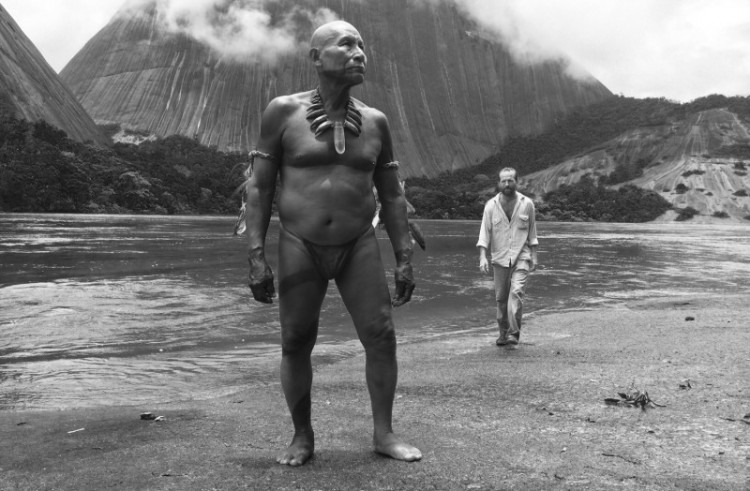Deep down in Colombia, South America there remains a deeply hidden mystery with the country’s jungles: The true history of the region and the people who inhabit it to this day.
The Colombian Amazon, half of the country itself, possesses the untold stories of millions of natives – those slaughtered in the early 20th century to produce rubber from rubber trees for European interests, and their descendants, proud and righteous people still wary of the West yet open to sharing their culture to those respectful of it.
With Embrace of the Serpent (El Abrazo de la serpiente), the newest film from Colombian native Ciro Guerra (The Wind Journeys – 2009), the stories of the natives living in the Amazon as told through the experiences of Karamakate, an Amazonian warrior-shaman and the assumed last survivor his people, are reflected. Taking place over 40 years in time – from the early 20th century to near the mid-century – we first meet the young Karamakate (Nilbio Torres) as he reluctantly agrees to take explorer Theordor Koch-Grünberg in search of the sacred and highly elusive Yakruna plant, told to have healing qualities that the German scientist needs to survive. Distrustful of Europeans who have decimated his land and people, he only agrees to the journey upon the promise to find his missing people, the Cohiuano, and on the word of local man Manduca (Yauenkü Miguee), a guide and former rubber plantation slave who escorts Koch-Grünberg on his adventures.
A then modern history unfolds on their long journey, as the trio confront fellow Amazonians – some untouched and others driven widely insane, despotic missionaries and their Amazonian acolytes, and more, all whom challenge their way of thinking and their own personal sanity. Alongside this journey the audience is transported to the future, where an older and wiser Karamakate (Antonio Bolívar Salvador) agrees to once more escort a European explorer, the Koch-Grünberg inspired botanist Richard Evans Schultes, also in search of the mysterious Yakaruna, though for potentially less altruistic reasons.

Serpent is inspired by Koch-Grünberg’s diary in part, but Guerra’s reasons for making it go beyond mere storytelling. Guerra had a deeply personal interest in the world of the Colombia’s Amazon. Feeling that his fellow Colombians have turned their back on the knowledge, he wanted to know more about it himself, and tell a filmic story told from the viewpoint of the native culture, not from the European or North American perspective that permeates stories told of the region. Says Guerra, “I wanted to tell a story…in which the protagonist wasn’t the white man as usual, but the native. This changes the entire perspective and renews it,” as natives are often shown as primitive savages in past films. He continues, “We wanted to be able to tell this story in a way that was true to their experience, yet was relatable to any other person on the planet.”
Written over the course of four years and shot in seven weeks in the jungles of Vaupés, the black & white filmed Serpent is the first fiction feature to be shot in the Colombian Amazon in more than 30 years. It is also the first Colombian film to feature an indigenous protagonist and to be told from his perspective.
While the relationship between both Karamakates and the European explorers seems to be paramount, it’s the familial bond between Young Karamakate and Manduca that remains most memorable. The proud and emotionally charged Manduca, pushing away any association of being a caboclo (traitor), is a fascinating study, him having embraced certain Western qualities while still being true to his people. That neither are trained actors is astonishing, as they inhabit the screen and play off one another like professional actors. The older Karamakate’s performance, brilliantly still yet moving, is also divine. Yet most brilliant is how time moves forward and backward throughout Serpent, almost seamlessly, and akin to the movements of the snake itself. In this way, the film takes on a life of its own even outside of the filmmaker’s ambitions.

Guerra may agree. He contents that the knowledge of the natives, while mostly lost, “is not something you can aspire to understand in a short time…It is related to life, generations, natural cycles; it really is a gigantic wall of knowledge that you can only admire and maybe try to scratch its surface.” While that knowledge may prove obscure, Serpent excels at cinematically working to rescue it, as well as to rescue a place in time that no longer exists as it was.
Introspective and haunting, especially in the scenes dealing with how religion affected the region, you cannot help but keep your eyes peeled during Embrace of the Serpent. A nominee for the Best Foreign Language Film Academy Award, you can see it now in New York City at the Film Forum and Lincoln Plaza Cinema, and beginning February 19th in Los Angeles at the Landmark Nuart.
EMBRACE OF THE SERPENT
125 mins | Colombia
Directed by Ciro Guerra
Written by Ciro Guerra and Jacques Toulemonde
Produced by Cristina Gallego
Starring Jan Bijvoet, Brionne Davis, Antonio Bolívar Salvador, Nilbio Torres, and Yauenkü Miguee
Related links

